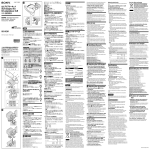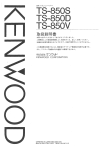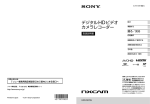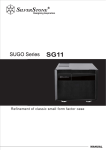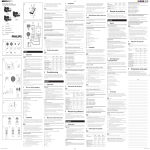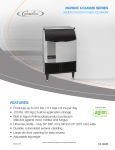Download Sony XLRK1M User's Manual
Transcript
4-443-502-01 (1) 4 REC CH SELECT(INPUT1 )スイッチ 5 ATT(INPUT1 )スイッチ 6 INPUT1(LINE/MIC/MIC+48V)スイッチ 7 ATT(INPUT2 )スイッチ 8 INPUT2(LINE/MIC/MIC+48V)スイッチ 9 LOW CUT(INPUT1 )スイッチ 10 AUTO/MAN(CH1 )スイッチ XLR アダプターキット XLR Adaptor Kit Kit adaptateur XLR 11 AUDIO LEVEL(CH1 )ダイヤル XLR 适配器套装 12 AUTO/MAN(CH2 )スイッチ 13 AUDIO LEVEL(CH2 )ダイヤル 14 LOW CUT(INPUT2 )スイッチ 取扱説明書 / Operating Instructions / 15 アクセサリーシュー Mode d’emploi / 16 接続端子 17 端子保護キャップ 18 固定ダイヤル 19 リリースレバー 20 ケーブルホルダー 21 INPUT2端子 22 INPUT1端子 外部音声の入力:21、22 音源の選択:6、8 音源レベルの選択:5、7 録音するチャンネルの選択:4 録音レベルの選択:10、11、12、13 風音低減の入/切:9、14 XLR-K1M © 2012 Sony Corporation Printed in Japan XLRアダプターを取り付ける 1 端子保護キャップをはずす。 2 XLRアダプターの接続端子をカメラのマルチイン 3 安全のために ソニー製品は安全に充分配慮して設計されています。しかし、ま ちがった使いかたをすると、火災などにより人身事故になること があり危険です。事故を防ぐために次のことを必ずお守りくださ い。 ˎ 安全のための注意事項を守る この「安全のために」の注意事項をよくお読みください。 ˎ 故障したら使わない 動作がおかしくなったり、コードなどが破損しているのに気づ いたら、すぐにソニーの相談窓口へ相談する。 ˎ 万一、異常が起きたら 変な音やにおい、 煙が出た場合は 電源を切る ソニーの相談窓口へ相談する 警告表示の意味 取扱説明書および製品では、次のような表示をしています。 表示の内容をよく理解してから本文をお読みください。 この表示の注意事項を守らないと、火災・感電 などにより死亡や大けがなど人身事故の原因 となります。 この表示の注意事項を守らないと、感電やその 他の事故によりけがをしたり周辺の家財に損 害を与えたりすることがあります。 注意を促す記号 XLRアダプターをブラケットのシューなどに取り 付け、固定ダイヤルをしっかり締める。 ˎ ブラケットは本機に付属していません。 電気製品は安全のための注意事項を守らない と、火災や人身事故になることがあります。 この取扱説明書には、事故を防ぐための重要な注意事項と 製品の取り扱いかたを示しています。 この取扱説明書をよくお読みのうえ、製品を安全にお使い ください。お読みになったあとは、いつでも見られるとこ ろに必ず保管してください。 ターフェースシューに取り付ける。 行為を禁止する記号 マルチインターフェースシュー搭載のソニー製レン ズ交換式デジタルHDビデオカメラレコーダーをお 使いのとき(イラスト-2参照) XLRアダプターの接続端子を取り付けた後に本機に同梱されてい るシュースペーサーをカメラのアクセサリシューに取り付けてく ださい。 XLRアダプターを取りはずすには 接続端子をマルチインターフェースシューからはずした後、XLR アダプターの固定ダイヤルをゆるめてはずす。 マイクを取り付ける 1 マイクホルダーのロックをはずし、取り付け部の 2 3 4 カバーを開ける。 マイクをマイクホルダーの取り付け部に入れ、カ バーを閉じ、マイクホルダーをロックする。 マイクは、型名(ECM-XM1 )が記された部分が上になるよう に取り付けます。 マイクケーブルをXLRアダプターのINPUT1端子 につなぐ。 接続する機器が1つの場合は、INPUT1端子につないでくださ い。 マイクケーブルをXLRアダプターのケーブルホル ダーに取り付ける。 音声の設定については、 「音の設定をする」をご覧ください。 マイクケーブルを取りはずすには マイクをマイクホルダーから取りはずす。 リリースレバーを下げながら、プラグを持って引き抜く。 音の設定をする 下記の注意事項を守らないと、 火災・感電により大けがの原因 となります。 製品および同梱物を、乳幼児の手の届く範囲に放置 しないでください。 乳幼児の手の届かない場所に置き、口に入れないよう注 意する。万一、飲み込んだ場合は、ただちに医師に相談 してください。 内部に水や異物を入れない 水や異物が入ると火災や感電の原因となります。万一、 水や異物が入ったときは、すぐにスイッチを切り、ソ ニーの相談窓口にご相談ください。 下記の注意事項を守らないと、 けがをしたり周辺の家財に損害を 与えることがあります。 付属マイクを使う 指向性のモノラル音声を収録できます。 1 2 湿気やほこり、油煙、湯気の多い場所や直射日光のあ たる場所には置かない 故障の原因となります。 落としたりぶつけたりしない 故障の原因となります。 主な特長 本機はマルチインターフェースシュー搭載機器対応のXLRアダプ ターとマイクロホンのキットです。 マルチインターフェースシューを搭載していても使用できないカ メラがあります。 対応機種はWEBをご確認ください。 2 各部の名前 1 ウインドスクリーン 2 マイク 3 マイクホルダー 3 INPUT1/INPUT2(LINE/MIC/MIC+48V)スイッチがLINEの ときは、入力レベルは+4dBuに固定されます。ATTスイッ チを切り換えても入力レベルは変わりません。 録音するチャンネルを設定する。 REC CH SELECT(INPUT1 )スイッチで、録音するチャンネル を選びます。 REC CH SELECT (INPUT1 ) スイッチの位置 CH1、CH2に録音される音声 CH1・CH2 INPUT1 CH1 INPUT1 INPUT2 ˎ CH1 CH2 CH1 CH2 XLR( 3PIN)プラグが2個ついているステレオマイクを使 うにはINPUT1端子にLch、INPUT2端子にRchを接続し、 REC CH SELECT(INPUT1 )スイッチをCH1に設定します。 主な仕様 最大外形寸 XLRアダプター(XLR-A1M)本体 法(約): 111 mm × 85.5 mm × 118 mm (幅/高さ/奥行き) (突起物、コード含まず) マイクロホン(ECM-XM1 ) 42 mm × 193 mm (直径/長さ) (ウインドスクリーン含む/コード含まず) 質量(約): XLRアダプター(XLR-A1M)本体 217 g マイクロホン(ECM-XM1 ) 118.5 g 動作温度: 0 ℃ ∼ 40 ℃ 保存温度: -20 ℃ ∼ +60 ℃ 入力端子: INPUT1/INPUT2端子:XLR型3ピン、凹 MIC:-60/-50/-40 dBu、3 kΩ LINE:+4 dBu、10 kΩ ( 0 dBu=0.775 Vrms) 同梱物: XLRアダプター(XLR-A1M) (1) (1) マイクロホン(ECM-XM1 ) ウインドスクリーン( 1 ) シュースペーサー( 1 ) 端子保護キャップ( 1 ) キャリングケース( 1 ) 印刷物一式 仕様および外観は、改良のため予告なく変更することがあります が、ご了承ください。 (マルチインターフェースシュー)”はソ “Multi Interface Shoe ニー株式会社の商標です。 保証書とアフターサービス 保証書 ˎ この製品には保証書が添付されていますので、お買い上げの際 お買い上げ店でお受け取りください。 ˎ 所定事項の記入および記載内容をお確かめのうえ、大切に保存 してください。 ˎ 保証期間は、お買い上げ日より1年間です。 アフターサービス 調子が悪いときはまずチェックを この取扱説明書をもう一度ご覧になってお調べください。 それでも具合が悪いときは ソニーの相談窓口にご相談ください。 保証期間中の修理は 保証書の記載内容に基づいて修理させていただきます。 詳しくは保証書をご覧ください。 保証期間経過後の修理は 修理によって機能が維持できる場合は、ご要望により有償修理さ せていただきます。 部品の保有期間について 当社では本機の補修用性能部品(製品の機能を維持するために必 要な部品)を、製造打ち切り後最低7年間保有しています。この部 品保有期間を修理可能の期間とさせていただきます。ただし、故 障の状況その他の事情により、修理に代えて製品交換をする場合 がありますのでご了承ください。保有期間が経過したあとも、故 障箇所によっては修理可能の場合がありますので、ソニーの相談 窓口にご相談ください。 ご相談になるときは、次のことをお知らせください。 ˎ 品名:XLR-K1M ˎ 故障の状態:できるだけ詳しく ˎ 購入年月日 REC CH SELECT(INPUT1 )スイッチを「CH1・ CH2 」に切り換える。 録音レベルを調節する INPUT1端子/INPUT2端子から入力した音声の録音レベルを調節 できます。 内蔵マイクとMIC入力端子の録音レベルは調節できません。 1 2 調節するチャンネル(CH1またはCH2 )のAUTO/ MANスイッチを「MAN」にする。 AUDIO LEVELダイヤルを回して、適正なレベル になるように音量を調節する。 適正なレベルになっているか、ヘッドホンやオーディオレベ ルメーターで確認してください。 AUTO/MANスイッチを「AUTO」にする。 風切り音を低減する INPUT1端子/INPUT2端子から入力した音声の風切り音を低減で きます。 LOW CUT(INPUT1 )スイッチまたはLOW CUT (INPUT2 )スイッチを「ON」にする。 外部音声機器などを使う 付属マイク以外のマイクや外部音声機器(ミキサーなど)を使うに は、以下のように設定してください。 1 入力する音源を選ぶ INPUT1端子/INPUT2端子に接続する機器に合わせて、 INPUT1/INPUT2(LINE/MIC/MIC+48V)スイッチを設定しま す。 外部音声機器(ミキサーなど):LINE ダイナミックマイクや電池内蔵のマイク:MIC +48V電源(ファンタム電源)対応のマイク:MIC+48V ご注意 ˎ 2 MIC+48Vにしたままで+48V電源に対応していない機器を 接続すると、接続した機器の故障の原因になりますので、接 続する前にご確認ください。 ˎ 接続しない端子のノイズが気になるときは、INPUT1/ INPUT2(LINE/MIC/MIC+48V)スイッチを「LINE」にしてく ださい。 マイクの入力レベルを設定する。 INPUT1/INPUT2(LINE/MIC/MIC+48V)スイッチが「MIC」か (INPUT1/INPUT2 )スイッチで入 「MIC+48V」のときは、ATT 力レベルを設定できます。マイクの感度に応じて調節してく ださい。 付属のマイクロホン(ECM-XM1 )の場合は、ATT 10dBがお すすめです。 入力レベルは、以下のようになります。 ATT 0dB:-60dBu ATT 10dB:-50dBu ATT 20dB:-40dBu ˋˋIncrease the separation between the equipment and receiver. ˋˋConnect the equipment into an outlet on a circuit different from that to which the receiver is connected. ˋˋConsult the dealer or an experienced radio/TV technician for help. THIS DEVICE COMPLIES WITH PART 15 OF THE FCC RULES. OPERATION IS SUBJECT TO THE FOLLOWING TWO CONDITIONS: (1) THIS DEVICE MAY NOT CAUSE HARMFUL INTERFERENCE, AND (2) THIS DEVICE MUST ACCEPT ANY INTERFERENCE RECEIVED, INCLUDING INTERFERENCE THAT MAY CAUSE UNDESIRED OPERATION. For the Customers in Europe Disposal of Old Electrical & Electronic Equipment (Applicable in the European Union and other European countries with separate collection systems) This symbol on the product or on its packaging indicates that this product shall not be treated as household waste. Instead it shall be handed over to the applicable collection point for the recycling of electrical and electronic equipment. By ensuring this product is disposed of correctly, you will help prevent potential negative consequences for the environment and human health, which could otherwise be caused by inappropriate waste handling of this product. The recycling of materials will help to conserve natural resources. For more detailed information about recycling of this product, please contact your local Civic Office, your household waste disposal service or the shop where you purchased the product. < Notice for the customers in the countries applying EU Directives > The manufacturer of this product is Sony Corporation, 1-7-1 Konan Minato-ku Tokyo, 108-0075 Japan. The Authorized Representative for EMC and product safety is Sony Deutschland GmbH, Hedelfinger Strasse 61, 70327 Stuttgart, Germany. For any service or guarantee matters please refer to the addresses given in separate service or guarantee documents. Features The XLR-K1M is a kit including an XLR Adaptor for a device equipped with a Multi Interface Shoe and a microphone. Some camera models with a Multi Interface Shoe cannot be used with this kit. For details on compatible camera models of this unit, visit the Sony website in your area, or consult your Sony dealer or local authorized Sony service facility. Notes on use ˎˎThe microphone is a precision instrument. Do not drop, knock it, or subject it to excessive shock. ˎˎIf the microphone is placed near speakers, a howling effect (acoustic feedback) may occur. If this happens, place the microphone as far as possible from the speakers, or lower the volume of the speaker. ˎˎDo not attach an external accessory such as an video light etc. that weighs more than 500 g to the Accessory Shoe. Identifying the parts 1 Wind screen 2 Microphone 3 Microphone holder 4 REC CH SELECT (INPUT1) switch 5 ATT (INPUT1) switch 6 INPUT1 (LINE/MIC/MIC+48V) switch 7 ATT (INPUT2) switch 8 INPUT2 (LINE/MIC/MIC+48V) switch 9 LOW CUT (INPUT1) switch 10AUTO/MAN (CH1) switch 11AUDIO LEVEL (CH1) dial 12AUTO/MAN (CH2) switch 13AUDIO LEVEL (CH2) dial 14LOW CUT (INPUT2) switch 15Accessory Shoe 16Connector plug 17Connector protect cap 18Lock dial 19Release lever 20Cable holder 21INPUT2 jack 22INPUT1 jack Inputting external sound: 21, 22 Selecting a sound source: 6, 8 Selecting a sound source level: 5, 7 Selecting channel setting for recording: 4 Selecting the recording level: 10, 11, 12, 13 Switching wind noise reduction to ON/OFF: 9, 14 自動調整に戻すには 取り扱い上のご注意 ˎ マイクロホンは精密機器です。落としたり、たたいたり、強い衝 撃を与えないでください。 ˎ 使用中、マイクロホンをスピーカーに近づけると“ピー”という 音が発生することがあります(ハウリング現象)。その場合は、 マイクロホンとスピーカーの距離をできるだけ離すか、スピー カーの音量を下げてください。 ˎ アクセサリーシューに取り付けるビデオライトなどは500g以 内のものをご使用ください。 ˎ この設定で、同じ音声がCH1、CH2の両方に録音されます。 「CH1 」にしてください。 CH1だけに録音したいときは、 内部を開けない 感電の原因となることがあります。 内部の点検や修理はソニーの相談窓口へご相談くださ い。 INPUT 1(LINE/MIC/MIC+48V)スイッチを 「MIC+48V」に切り換える。 ご注意 Before operating the product, please read this manual thoroughly and retain it for future reference. WARNING To reduce fire or shock hazard, do not expose the unit to rain or moisture. Keep out of reach of small children to prevent accidental swallowing. For the Customers in the U.S.A. CAUTION You are cautioned that any changes or modifications not expressly approved in this manual could void your authority to operate this equipment. Note: This equipment has been tested and found to comply with the limits for a Class B digital device, pursuant to Part 15 of the FCC Rules. These limits are designed to provide reasonable protection against harmful interference in a residential installation. This equipment generates, uses, and can radiate radio frequency energy and, if not installed and used in accordance with the instructions, may cause harmful interference to radio communications. However, there is no guarantee that interference will not occur in a particular installation. If this equipment does cause harmful interference to radio or television reception, which can be determined by turning the equipment off and on, the user is encouraged to try to correct the interference by one or more of the following measures: ˋˋReorient or relocate the receiving antenna. Attaching the XLR Adaptor 1 Detach the connector protect cap from the connector plug of the XLR Adaptor. 2 Connect the connector plug of the XLR Adaptor to the Multi Interface Shoe of the camera. 3 Attach the XLR Adaptor to the shoe of the bracket and tighten the lock dial of the XLR Adaptor. ˎˎA bracket is not included with the XLR-K1M. When using the Sony Interchangeable Lens Digital HD Video Camera Recorder that have a Multi Interface Shoe (See illustration -2) Attaching the microphone 1 Unlock the stopper of the microphone holder and open the cover. 2 Align the convex part of the microphone with the concave part of the holder, and then place the microphone into the holder. Close the cover and lock the stopper securely. Be sure to place the microphone with the model name (ECM-XM1) facing upward. 3 Connect the connector plug of the microphone to the INPUT1 jack on the XLR Adaptor. Connect the connector plug of the microphone to the INPUT 1 jack if you connect one device. 4 Put the microphone cable into the cable holder on the XLR Adaptor. See “ Audio setup” for audio recording. When detaching the microphone cable Detach the microphone from the microphone holder. Unplug the microphone plug while pressing the release lever down. Audio setup Using the supplied microphone You can record monaural sound with the super-directional microphone. 1 Set the INPUT1 (LINE/MIC/MIC+48V) switch to MIC+48V. 2 Set the REC CH SELECT (INPUT1) switch to CH1·CH2. This setting enables recording on both CH1 and CH2. Set the switch to CH1 if you want to record on CH1 only. Adjusting the recording level You can adjust the recording level input from the INPUT1/ INPUT2 jacks. You cannot adjust the recording level of the internal microphone and MIC input jack. 1 Set the AUTO/MAN (CH1/CH2) switch of the channel to be adjusted to MAN. 2 Turn the AUDIO LEVEL dial to adjust the volume to the proper level. Check that the volume is at the proper level, with headphones or audio level meter. To restore automatic adjustment Set the AUTO/MAN (CH1/CH2) switch to AUTO. Reducing wind noise You can reduce wind noise input from the INPUT1/ INPUT2 jacks. Set the LOW CUT (INPUT1) switch or LOW CUT (INPUT2) switch to ON. Using an external audio device Set as follows when you use a microphone other than the supplied microphone or an external audio device (mixer, etc.). 1 Select the sound source to be input. Set the INPUT1/INPUT2 (LINE/MIC/MIC+48V) switch according to the device to be connected to the INPUT1/INPUT2 jacks. External audio device (mixer, etc.): LINE Dynamic microphone or microphone with built-in battery: MIC Microphone that is 48V phantom power compliant: MIC+48V Notes ˎˎIf you connect a device that does not support 48V phantom power, malfunction may result from setting this switch to MIC+48V. Check before connecting the device. ˎˎIf noise from the unused jack bothers you, set the INPUT1/INPUT2 (LINE/MIC/MIC+48V) switch of the unused jack to LINE. 2 Set the input level of the microphone. When the INPUT1/INPUT2 (LINE/MIC/MIC+48V) switch is set to MIC or MIC+48V, you can set the input level with the ATT (INPUT1/INPUT2) switch. Adjust according to the microphone sensitivity. ATT 10dB is recommended when you use the supplied microphone (ECM-XM1). The input levels are as follows. ATT 0dB: -60dBu ATT 10dB: -50dBu ATT 20dB: -40dBu Notes ˎˎWhen the INPUT1/INPUT2 (LINE/MIC/ MIC+48V) switch is set to LINE, the input level is fixed to +4dBu. Even if you reset the ATT switch, the input level does not change. 3 Set the channel to be recorded. You can select the channel to be recorded, with the REC CH SELECT (INPUT1) switch. Position of the REC CH SELECT Audio recorded on CH1 & CH2 (INPUT1) switch CH1 INPUT1 CH1. CH2 CH2 CH1 INPUT1 CH1 INPUT2 CH2 ˎˎTo use a stereo microphone with two XLR (3PIN) plugs, connect Lch to the INPUT1 jack and Rch to the INPUT2 jack, and set the REC CH SELECT (INPUT1) switch to CH1. Attach the shoe spacer supplied with this unit to the Accessory Shoe of the camera after attaching the connector plug of the XLR Adaptor. When detaching the XLR Adaptor Unplug the connector plug of the XLR Adaptor from the Multi Interface Shoe beforehand. Detach the XLR Adaptor after having loosened the lock dial of the XLR Adaptor. (Continued on the reverse side.) (Continued from the front side.) Specifications Maximum dimensions XLR Adaptor (XLR-A1M) unit (Approx.) 111 mm × 85.5 mm × 118 mm (w / h / d) (4 3/8 in. × 3 3/8 in. × 4 3/4 in.) (excluding the cord and projecting parts) Microphone (ECM-XM1) 42 mm × 193 mm (Diameter/ Length) (1 11/16 in. × 7 5/8 in.) (including the wind screen / excluding the cord) Mass (Approx.) XLR Adaptor (XLR-A1M) unit 217 g (7.7oz) Microphone (ECM-XM1) 118.5 g (4.2oz) Operating temperature 0 °C to 40 °C (32 °F to 104 °F) Storage temperature -20 °C to +60 °C (-4 °F to +140 °F) Input jacks: INPUT1/INPUT2 jacks: XLR3-pin, female MIC: -60 dBu /-50 dBu /-40 dBu, 3 kΩ(kilohms) LINE: +4 dBu, 10 kΩ (kilohms) (0 dBu=0.775 Vrms) Included items XLR Adaptor (XLR-A1M) (1) Microphone (ECM-XM1) (1) Wind screen (1) Shoe spacer (1) Connector protect cap (1) Carrying case (1) Set of printed documentation Design and specifications are subject to change without notice. “Multi Interface Shoe” is a trademark of Sony Corporation. Avant d’utiliser ce produit, prière de lire attentivement ce mode d’emploi et de le conserver pour toute référence future. AVERTISSEMENT Afin de réduire les risques d’incendie ou de décharge électrique, n’exposez pas cet appareil à la pluie ou à l’humidité. Rangez hors de portée des enfants pour éviter toute ingestion accidentelle. À l’intention des clients aux É.-U. AVERTISSEMENT Par la présente, vous êtes avisé du fait que tout changement ou toute modification ne faisant pas l’objet d’une autorisation expresse dans le présent manuel pourrait annuler votre droit d’utiliser l’appareil. Note L’appareil a été testé et est conforme aux exigences d’un appareil numérique de Classe B, conformément à la Partie 15 de la réglementation de la FCC. Ces critères sont conçus pour fournir une protection raisonnable contre les interférences nuisibles dans un environnement résidentiel. L’appareil génère, utilise et peut émettre des fréquences radio; s’il n’est pas installé et utilisé conformément aux instructions, il pourrait provoquer des interférences nuisibles aux communications radio. Cependant, il n’est pas possible de garantir que des interférences ne seront pas provoquées dans certaines conditions particulières. Si l’appareil devait provoquer des interférences nuisibles à la réception radio ou à la télévision, ce qui peut être démontré en allumant et éteignant l’appareil, il est recommandé à l’utilisateur d’essayer de corriger cette situation par l’une ou l’autre des mesures suivantes : ˋˋRéorienter ou déplacer l’antenne réceptrice. ˋˋAugmenter la distance entre l’appareil et le récepteur. ˋˋBrancher l’appareil dans une prise ou sur un circuit différent de celui sur lequel le récepteur est branché. ˋˋConsulter le détaillant ou un technicien expérimenté en radio/téléviseurs. Cet appareil est conforme à la section 15 des règlements FCC. Son fonctionnement est soumis aux deux conditions suivantes : (1) cet appareil ne doit pas provoquer d’interférences nuisibles, (2) cet appareil doit accepter toute interférence, y compris celles susceptibles de provoquer son fonctionnement indésirable. Pour les clients en Europe Pour le détail sur les modèles d’appareils photo/ caméscopes compatibles avec ce microphone, consultez le site Sony de votre région, ou adressez-vous à votre revendeur Sony ou à un service après-vente agréé Sony. Remarques sur l’emploi ˎˎLe microphone est un instrument de précision. Ne le laissez pas tomber, ne le cognez pas et ne le soumettez pas à des chocs. ˎˎSi le microphone est placé près d’enceintes, un hurlement (rétroaction acoustique) peut se produire. Dans ce cas, éloignez le plus possible le microphone des enceintes, ou bien réduisez le volume du microphone. ˎˎNe rattachez pas d’accessoire, par exemple une lampe vidéo, pesant plus de 500 g à la griffe porte-accessoire. Identification des éléments 1 Bonnette antivent 2 Microphone 3 Support de microphone 4 Commutateur REC CH SELECT (INPUT1) 5 Commutateur ATT (INPUT1) 6 Commutateur INPUT1 (LINE/MIC/MIC+48V) 7 Commutateur ATT (INPUT2) 8 Commutateur INPUT2 (LINE/MIC/MIC+48V) 9 Commutateur LOW CUT (INPUT1) 10Commutateur AUTO/MAN (CH1) 11Molette AUDIO LEVEL (CH1) 12Commutateur AUTO/MAN (CH2) 13Molette AUDIO LEVEL (CH2) 14Commutateur LOW CUT (INPUT2) 15Griffe porte-accessoire 16Fiche-connecteur 17Capuchon de protection de connecteur 18Molette de verrouillage 19Levier de libération 20Support de câble 21Prise d’entrée INPUT2 22Prise d’entrée INPUT1 Transmission d’un son externe: 21, 22 Sélection d’une source sonore: 6, 8 Sélection du niveau d’une source sonore: 5, 7 Sélection d’un canal pour l’enregistrement: 4 Sélection du niveau d’enregistrement: 10, 11, 12, 13 Activation/désactivation de la réduction du bruit du vent: 9, 14 Fixation de l’adaptateur XLR 1 Détachez le capuchon de protection de connecteur de la fiche-connecteur de l’adaptateur XLR. 2 Raccordez la fiche-connecteur de l’adaptateur XLR à la griffe multi-interface de l’appareil photo/caméscope. 3 Rattachez l’adaptateur XLR à la griffe du support et serrez la molette de verrouillage de l’adaptateur XLR. ˎˎLe support n’est pas fourni avec le XLR-K1M. Lorsqu'un caméscope numérique HD à objectif interchangeable pourvu d'une griffe multi-interface est utilisé (Voir l’illustration -2) Rattachez l’entretoise fournie avec cet accessoire à la griffe porte-accessoire du caméscope après avoir branché la fiche-connecteur de l’adaptateur XLR. Lorsque l’adaptateur XLR est détaché Débranchez d’abord la fiche-connecteur de l’adaptateur XLR de la griffe multi-interface. Détachez l’adaptateur XLR après avoir desserré la molette de verrouillage de l’adaptateur XLR. Fixation du microphone 1 Débloquez la fermeture du support de microphone et ouvrez le couvercle. 2 Alignez la partie convexe du microphone sur la partie concave du support, puis mettez le microphone dans le support. Fermez le couvercle et bloquez bien la fermeture. Veillez à mettre le microphone avec le nom de modèle (ECM-XM1) orienté vers le haut. Traitement des appareils électriques et électroniques en fin de vie (Applicable dans les pays de l’Union Européenne et aux autres pays européens disposant de systèmes de collecte sélective) Ce symbole, apposé sur le produit ou sur son emballage, indique que ce produit ne doit pas être traité avec les déchets ménagers. Il doit être remis à un point de collecte approprié pour le recyclage des équipements électriques et électroniques. En vous assurant que ce produit sont mis au rebut de façon appropriée, vous participez activement à la prévention des conséquences négatives que leur mauvais traitement pourrait provoquer sur l’environnement et sur la santé humaine. Le recyclage des matériaux contribue par ailleurs à la préservation des ressources naturelles. Pour toute information complémentaire au sujet du recyclage de ce produit, vous pouvez contacter votre municipalité, votre déchetterie locale ou le point de vente où vous avez acheté le produit. 3 Raccordez la fiche-connecteur du microphone à la prise INPUT 1 de l’adaptateur XLR. < Avis aux consommateurs des pays appliquant les Directives UE > Vous pouvez enregistrer le son en monophonie avec le microphone super-directionnel. Le fabricant de ce produit est Sony Corporation, 1-7-1 Konan Minato-ku Tokyo, 108-0075 Japon. Le représentant autorisé pour les questions de compatibilité électromagnétique (EMC) et la sécurité des produits est Sony Deutschland GmbH, Hedelfinger Strasse 61, 70327 Stuttgart, Allemagne. Pour toute question relative au SAV ou à la garantie, merci de bien vouloir vous référer aux coordonnées contenues dans les documents relatifs au SAV ou la garantie. Caractéristiques Le XLR-K1M est un kit comprenant un adaptateur XLR pour appareil à griffe multi-interface et un microphone. Certains modèles d’appareils photo/caméscopes à griffe multi-interface ne peuvent pas être utilisés avec ce kit. Raccordez la fiche-connecteur du microphone à la prise INPUT 1 si vous raccordez un appareil. 4 Mettez le câble de microphone dans le support de câble sur l’adaptateur XLR. Voir « Réglage du son » pour l’enregistrement du son. Lorsque le câble de microphone est détaché Détachez le microphone du support de microphone. Débranchez la fiche de microphone tout en appuyant sur le levier de libération. Réglage du son Utilisation du microphone fourni 1 Réglez le commutateur INPUT1 (LINE/MIC/ MIC+48V) sur MIC+48V. 2 Réglez le commutateur REC CH SELECT (INPUT1) sur CH1·CH2. Ce réglage permet d’enregistrer sur les deux canaux CH et CH2. Réglez le commutateur sur CH1 si vous voulez enregistrer sur CH1 seulement. Réglage du niveau d’enregistrement Vous pouvez régler le niveau d’enregistrement du son provenant des prises INPUT1/INPUT2. Vous ne pouvez pas régler le niveau d’enregistrement du microphone interne et de la prise d’entrée MIC. 1 Réglez le commutateur AUTO/MAN (CH1/ CH2) du canal devant être ajusté sur MAN. 2 Tournez la molette AUDIO LEVEL pour ajuster le volume au niveau souhaité. Assurez-vous que le volume est au niveau correct avec un casque d’écoute ou un indicateur de niveau sonore. Pour revenir au réglage automatique Réglez le commutateur AUTO/MAN (CH1/CH2) sur AUTO. Réduction du bruit du vent Vous pouvez réduire le bruit du vent provenant des prises INPUT1/INPUT2. Réglez le commutateur LOW CUT (INPUT1) ou le commutateur LOW CUT (INPUT2) sur ON. Utilisation d’un appareil audio externe Faites les réglages suivants lorsque vous utilisez un microphone autre que le microphone fourni ou un appareil audio externe (mixeur, etc.). 1 Sélectionnez la source sonore à transmettre. Réglez le commutateur INPUT1/INPUT2 (LINE/MIC/ MIC+48V) selon l’appareil devant être branché sur les prises INPUT1/INPUT2. Appareil audio externe (mixeur, etc.) : LINE Microphone dynamique ou microphone avec pile intégrée : MIC Microphone compatible ayant une alimentation fantôme de 48 V. MIC+48V Remarques ˎˎSi vous raccordez un appareil ne prenant pas en charge une alimentation fantôme de 48V, le réglage de ce commutateur sur MIC+48V peut entraîner un dysfonctionnement. Vérifiez avant de raccorder l’appareil. ˎˎSi le bruit émis par la prise non utilisée vous dérange, réglez le commutateur INPUT1/INPUT2 (LINE/MIC/MIC+48V) de la prise non utilisée sur LINE. 2 Réglez le niveau d’entrée du microphone. Lorsque le commutateur INPUT1/INPUT2 (LINE/ MIC/MIC+48V) est réglé sur MIC ou MIC+48V, vous pouvez régler le niveau d’entrée avec le commutateur ATT (INPUT1/INPUT2). Réglez-le en fonction de la sensibilité du microphone. ATT 10dB est recommandé lorsque vous utilisez le microphone fourni (ECM-XM1). Les niveaux d’entrée sont les suivants. ATT 0dB : -60 dBu ATT 10dB : -50 dBu ATT 20dB : -40 dBu Remarques ˎˎLorsque le commutateur INPUT1/INPUT2 (LINE/ MIC/MIC+48V) est réglé sur LINE, le niveau d’entrée reste fixé sur 4dBu. Même si le commutateur ATT est réinitialisé, le niveau d’entrée ne change pas. 3 Réglez le canal à enregistrer. Vous pouvez sélectionner le canal à enregistrer avec le commutateur REC CH SELECT (INPUT1). Position du commutateur Son enregistré sur CH1 & CH2 REC CH SELECT (INPUT1) INPUT1 CH1 CH1. CH2 CH2 CH1 INPUT1 CH1 INPUT2 CH2 ˎˎPour utiliser un microphone stéréo avec deux fiches XLR (3PIN), raccordez le canal gauche à la prise INPUT1 et le canal droit à la prise INPUT2, et réglez le commutateur REC CH SELECT (INPUT1) sur CH1. Spécifications Dimensions (environ) Adaptateur XLR (XLR-A1M) 111 mm × 85,5 mm × 118 mm (l / h / p) (4 3/8 in. × 3 3/8 in. × 4 3/4 in.) (cordon et parties saillantes non compris) Microphone (ECM-XM1) 42 mm × 193 mm (diamètre/ longueur) (1 11/16 in. × 7 5/8 in.) (bonnette antivent comprise / cordon non compris) Poids (environ) Adaptateur XLR (XLR-A1M) 217 g (7,7 oz) Microphone (ECM-XM1) 118,5 g (4,2 oz) Température de 0 °C à 40 °C (32 °F à 104 °F) fonctionnement Température -20 °C à +60 °C (-4 °F à +140 °F) d’entreposage Prises d’entrée: Prises INPUT1/INPUT2 : XLR 3 broches, femelle MIC : -60 dBu /-50 dBu /-40 dBu, 3 kΩ (kilohms) LINE : +4 dBu, 10 kΩ (kilohms) (0 dBu=0,775 efficace) Articles inclus Adaptateur XLR (XLR-A1M) (1) Microphone (ECM-XM1) (1) Bonnette antivent (1) Entretoise de griffe (1) Capuchon de protection de connecteur (1) Étui de transport (1) Jeu de documents imprimés La conception et les spécifications peuvent être modifiées sans préavis. « Multi Interface Shoe » est une marque commerciale de Sony Corporation. 上。 如果只想记录到 CH1 上,请将此开关 设为 CH1。 产品 调节记录电平 在操作本产品前,请通读本手册,然后保存好 本手册以备将来参考。 警告 为减少发生火灾或触电的危险,请勿让本装置 淋雨或受潮。 应避免儿童触及,以防误吞。 特性 XLR-K1M 是一款套装产品,它包括 XLR 适配 器(用于配备多接口热靴的设备)及麦克风。 有些带有多接口热靴的相机/摄像机并不能使用 本套装。 有关与本装置兼容的相机/摄像机型号的详细信 息,请访问所在地区的 Sony 网站,或者咨询您 的 Sony 经销商或当地的 Sony 授权服务机构。 使用须知 本款麦克风属精密设备。 请勿使其摔落,或 者受到撞击或过大震动。 如果麦克风位于扬声器旁边,可能会有呼啸声 (回声)。 这种情况下,请将麦克风尽量远 离扬声器,或者调低扬声器的音量。 请勿在配件热靴上安装重量超过 500 g 的外 部配件,如摄像灯。 部件识别 1 挡风罩 2 麦克风 3 麦克风架 4 REC CH SELECT (INPUT1) 开关 5 ATT (INPUT1) 开关 6 INPUT1 (LINE/MIC/MIC+48V) 开关 7 ATT (INPUT2) 开关 8 INPUT2 (LINE/MIC/MIC+48V) 开关 9 LOW CUT (INPUT1) 开关 10 AUTO/MAN (CH1) 开关 11AUDIO LEVEL (CH1) 转盘 12 AUTO/MAN (CH2) 开关 13 AUDIO LEVEL (CH2) 转盘 14 LOW CUT (INPUT2) 开关 15 配件热靴 16 连接器插头 17 连接器保护帽 18 锁定转盘 19 释放杆 20 电缆架 21 INPUT2 插孔 22 INPUT1 插孔 输入外部声音: 21, 22 选择声源: 6, 8 选择声源电平: 5, 7 选择记录时的声道设置: 4 选择记录电平: 10, 11, 12, 13 开/关降风噪功能: 9, 14 安装 XLR 适配器 1 取下 XLR 适配器的连接器插头上的连接器保 护帽。 2 将 XLR 适配器的连接器插头连接至相机/摄 像机的多接口热靴。 3 将 XLR 适配器安装到支架的热靴上,然后将 XLR 适配器的锁定转盘拧紧。 XLR-K1M 未附带支架。 使用带有多接口热靴的 Sony 可更换镜头数 码 HD 摄录一体机时(参见图 -2) 在安装好 XLR 适配器的连接器插头后,请将本 装置附带的热靴隔离垫片安装到相机/摄像机的 配件热靴上。 拆卸 XLR 适配器时 预先从多接口热靴上拔下 XLR 适配器的连接器 插头。 松开 XLR 适配器的锁定转盘,然后将 XLR 适 配器卸下。 您可以调节从 INPUT1/INPUT2 插孔输入的记 录电平。 内部麦克风及 MIC 输入插孔的记录电平是无法 调节的。 1 将所要调节的声道的 AUTO/MAN (CH1/ CH2) 开关设为 MAN。 2 转动 AUDIO LEVEL 转盘,将音量调节至适 当的水平。 利用耳机或音量检测仪检查音量是否合适。 如需恢复自动调节 将 AUTO/MAN (CH1/CH2) 开关设为 AUTO。 降风噪 您可以降低从 INPUT1/INPUT2 插孔输入的风 噪。 将 LOW CUT (INPUT1) 开关或 LOW CUT (INPUT2) 开关设为 ON。 使用外部音频设备 使用非附带的麦克风或外部音频设备(混音器 等)时,请按如下所示进行设置。 1 选择所要输入的声源。 根据要连接至 INPUT1/INPUT2 插孔的设 备,设置 INPUT1/INPUT2 (LINE/MIC/ MIC+48V) 开关。 外部音频设备(混音器等): LINE 动态麦克风或带内置电池的麦克风: MIC 符合 48V 幻路供电标准的麦克风: MIC+48V 注意 如果连接的设备不支持 48V 幻路供电, 则将此开关设为 MIC+48V 可能会导致故 障。 请在连接设备之前进行核查。 如果是未用的插孔发出噪音,请将此 插孔的 INPUT1/INPUT2 (LINE/MIC/ MIC+48V) 开关设为 LINE。 2 设置麦克风的输入电平。 当 INPUT1/INPUT2 (LINE/MIC/MIC+48V) 开关设为 MIC 或 MIC+48V 时,可以利用 ATT (INPUT1/INPUT2) 开关设置输入电 平。 请根据麦克风的灵敏度进行相应调节。 使用附带的麦克风 (ECM-XM1) 时,建议选 择 ATT 10dB。 输入电平如下所示。 ATT 0dB: -60dBu ATT 10dB: -50dBu ATT 20dB: -40dBu 注意 当 INPUT1/INPUT2 (LINE/MIC/ MIC+48V) 开关设为 LINE 时,输入电平 将固定为 +4dBu。 即使重置 ATT 开关, 输入电平也不会发生改变。 3 设置记录声道。 利用 REC CH SELECT (INPUT1) 开关可以 选择记录所用的声道。 REC CH SELECT 音频记录至 CH1 和 CH2 (INPUT1) 开 关的位置 CH1 INPUT1 CH1. CH2 CH2 INPUT1 CH1 CH1 INPUT2 CH2 要通过两个 XLR (3PIN) 插头使用立体声 麦克风,请将 L 声道连接至 INPUT1 插 孔,将 R 声道连接至 INPUT2 插孔,同 时将 REC CH SELECT (INPUT1) 开关设 为 CH1。 规格 尺寸(约) 安装麦克风 1 松开麦克风架的制动器,打开盖子。 2 将麦克风的凸面部分与麦克风架的凹面部分 对准,然后将麦克风放入支架中。关上盖子 并将制动器牢牢锁紧。 放置麦克风时,请务必让型号名 (ECMXM1) 朝上。 3 将麦克风的连接器插头连接至 XLR 适配器的 INPUT1 插孔。 如果只连接一台设备,可将麦克风的连接器 插头连接至 INPUT1 插孔。 4 将麦克风电缆放入 XLR 适配器的电缆架中。 有关录音事宜,请参阅“ 音频设置”。 质量(约) 操作温度 存放温度 输入插孔: 拆卸麦克风电缆时 将麦克风从麦克风架上卸下。 下压释放杆的同时拔下麦克风插头。 音频设置 所含物品 使用附带的麦克风 您可以通过超级指向式麦克风录制单声道声 音。 1 将 INPUT1 (LINE/MIC/MIC+48V) 开关设为 MIC+48V。 2 将 REC CH SELECT (INPUT1) 开关设为 CH1·CH2。 此设置可将声音同时记录到 CH1 和 CH2 上。 如果只想记录到 CH1 上,请将此开关 设为 CH1。 XLR 适配器 (XLR-A1M) 单 元 111 mm × 85.5 mm × 118 mm(宽/高/长)(不 包括连接线及突出部位) 麦克风 (ECM-XM1) 42 mm × 193 mm(直径/ 长度)(包括挡风罩/不包括 连接线) XLR 适配器 (XLR-A1M) 单 元 217 g 麦克风 (ECM-XM1) 118.5 g 0 °C - 40 °C -20 °C - +60 °C INPUT1/INPUT2 插孔: XLR (3PIN),下凹 MIC: -60 dBu /-50 dBu /-40 dBu,3 kΩ(千欧) LINE: +4 dBu,10 kΩ (千欧)(0 dBu=0.775 Vrms) XLR 适配器 (XLR-A1M) (1) 麦克风 (ECM-XM1) (1) 挡风罩 (1) 热靴隔离垫片 (1) 连接器保护帽 (1) 携带包 (1) 成套印刷文件 设计或规格如有变动,恕不另行通知。 “Multi Interface Shoe”是 Sony Corporation 的商标。 调节记录电平 您可以调节从 INPUT1/INPUT2 插孔输入的记 录电平。 内部麦克风及 MIC 输入插孔的记录电平是无法 调节的。 产品 部件 有毒有害物质或元素 部件 名称 有毒有害物质或元素 铅 汞 镉 六价铬 多溴联苯 多溴二苯醚 (Pb) (Hg) (Cd) (Cr(VI)) (PBB) (PBDE) 内置 线路 × ○ ○ ○ ○ ○ 板 外壳 × ○ ○ ○ ○ ○ 附件 × ○ ○ ○ ○ ○ ○:表示该有毒有害物质在该部件所有均质材 料中的含量均在SJ/T11363-2006标准规 定的限量要求以下。 ×:表示该有毒有害物质至少在该部件的某一 均质材料中的含量超出SJ/T11363-2006 标准规定的限量要求。 制造商: 索尼公司 总经销商: 索尼(中国)有限公司 总经销商地址: 北京市朝阳区 太阳宫中路12号楼 冠城大厦701 日本制造(主机) 出版日期: 2012 年 9 月
This document in other languages
- français: Sony XLRK1M
- 日本語: Sony XLRK1M


